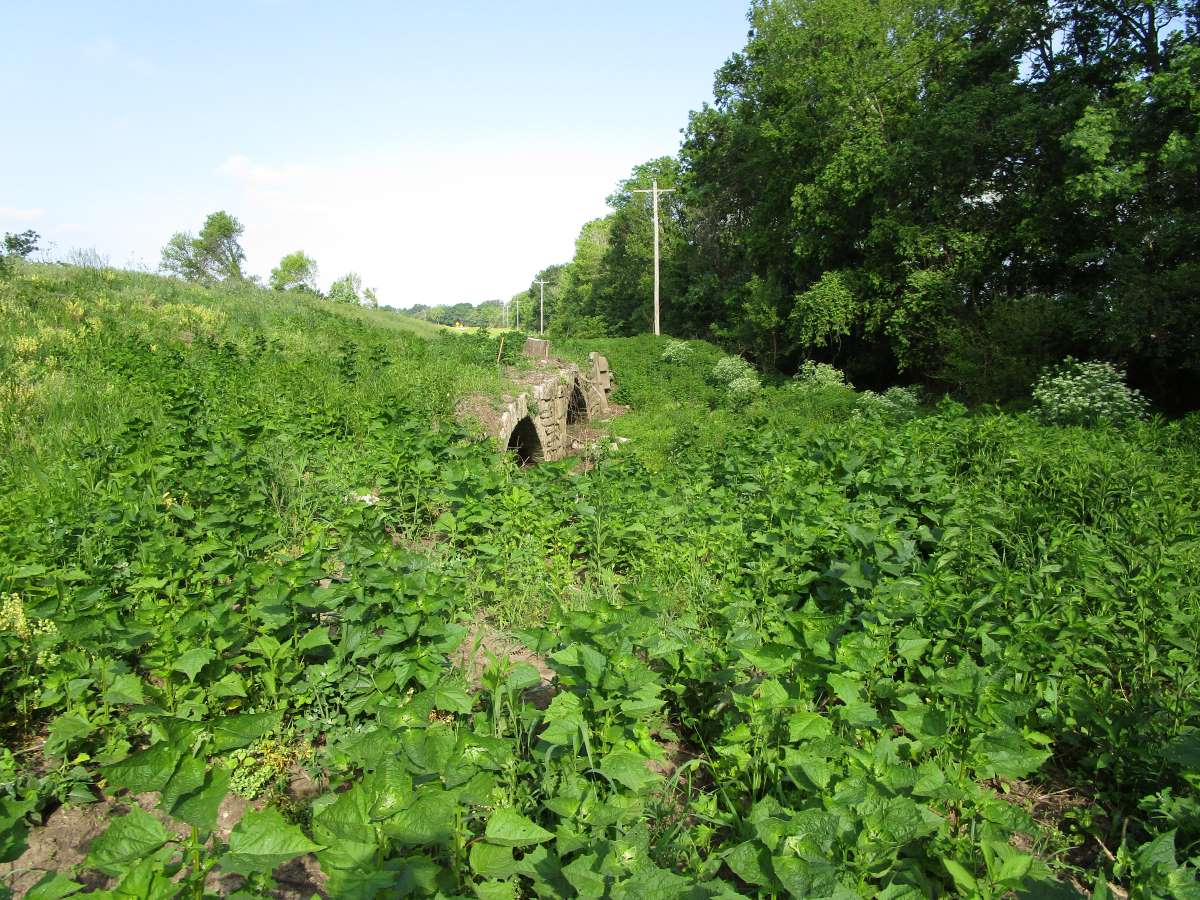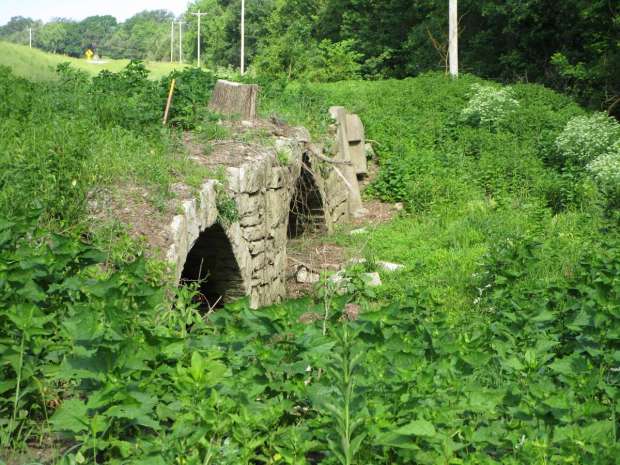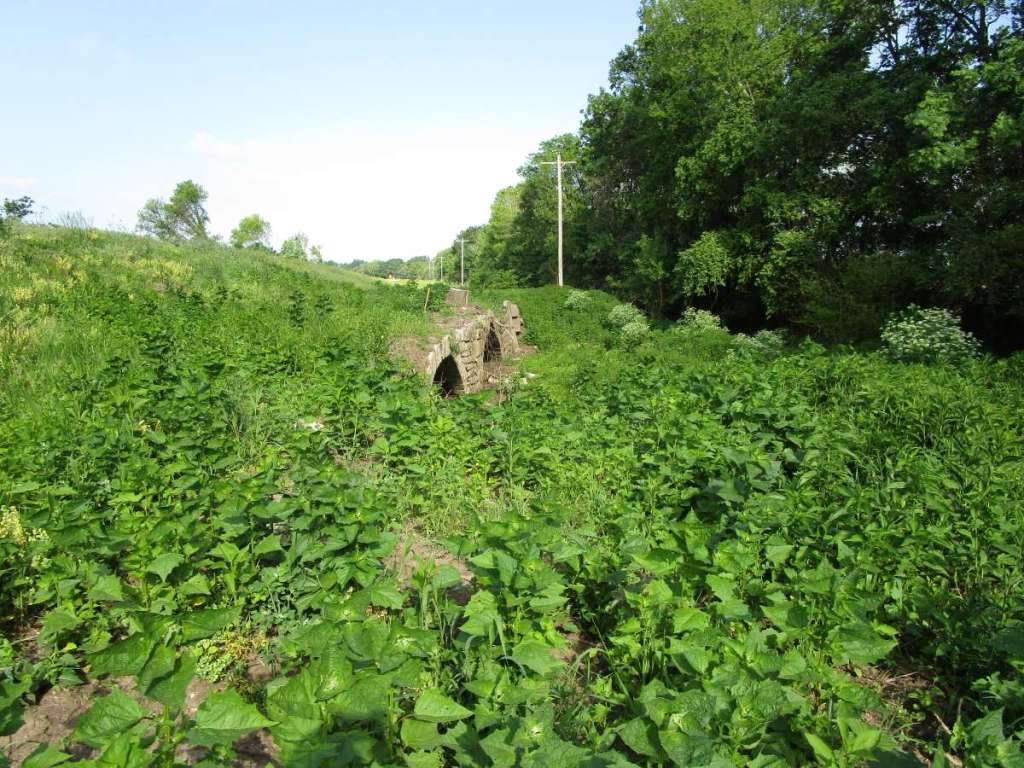Of all the stone arch bridges in Butler County, one stood out. Peter Johnson’s Bridge, which spanned the Little Walnut near Leon, received much attention for many reasons. This was Butler’s 4th stone arch bridge, was the second stone arch bridge built by Walter Sharp in Butler, and was the most substantial stone arch bridge Butler had tackled at the time. It also received much attention due to a naming controversy, and spawned in the Leon area a regular Harvest Home celebration to commemorate its completion, though as time went on the original cause for this celebration was forgotten. This bridge seemed to have been lost to time, as the road it was on, Quito Road, is now a blacktop with a large 1952 iron bridge spanning the river. We thought this bridge was no longer in existence, until we spotted a concrete curb on the north side of the road embankment to the west of the current bridge. An investigation revealed the 1895 Peter Johnson’s Bridge, still in a remarkable state of preservation, built into the road embankment and high and dry.
Peter Johnson’s Bridge Today
Peter Johnson’s Bridge no longer carries the road nor spans the river. Located west of Quito Road’s current bridge over the Little Walnut, this double-arch bridge is now partially buried in the road embankment on the north side of the blacktop. That said, the upstream face of the bridge is entirely visible.

The condition of the structure appears to be good, the main damage being the loss of the top line of stones. It appears to be structurally sound. It was previously overgrown with trees, but the trees were all cleared out relatively recently.

The workmanship on this structure seems to be of remarkable quality. One interesting feature is the fact that there is a noticeable amount of damage to the keystone on the south face of the west arch. In the naming controversy surrounding this bridge, an unknown person persisted in cutting Peter Johnson’s name off the bridge. The missing keystone is probably related to this occurrence, as is some of the damage to the surrounding stones.

The Historic Significance
Peter Johnson’s Bridge is arguably the most historically significant of all the remaining Butler County stone arch bridges. This big structure has several noteworthy details:
- A Walter Sharp Bridge: Walter Sharp bridges are not common in Butler; Peter Johnson’s is one of four known Sharp bridges in the county. It is also the second Walter Sharp bridge ever built in Butler.
- A Landmark in Sharp’s Career: Peter Johnson’s Bridge is one of Walter Sharp’s earliest bridges. Built while Walter Sharp still contracted with his brothers, this bridge was a significant part of how Walter Sharp’s career got off the ground, for it was a famous, major structure. His career in Butler became so successful that Walter Sharp ended up moving to El Dorado from Marion County.
- A Landmark in Butler County: To the best of our knowledge, this is the 4th stone arch bridge of any size Butler County proper built, and the 3rd major one. The success of this structure, which was the largest one built at the time, helped to guarantee that Butler County would continue to build stone arch bridges. Butler’s success, in turn, encouraged other counties, including Cowley County, to also build bridges with stone. An 1882 culvert aside, the county began experimenting with stone arch bridges in earnest in 1894 with a 20′ bridge near Towanda. By 1895, the county was seriously building bridges of stone. This was one of the earliest.
- Age: This is the oldest known major stone arch bridge in Butler County, dating from 1895. (Latham has three stone culverts that are likely older, but these are only culverts and are not very well documented.)
- Size: This is the second largest stone arch bridge in Butler, surpassed only by the Ellis Bridge over the Walnut River near Cassoday.
- Well-Documented History: Most stone arch bridges received surprisingly little attention in the newspapers. As a major structure, Peter Johnson’s Bridge is very well documented, and is an important part of county history.
- Condition: Despite some missing stones on top, this structure remains remarkably preserved.
Conclusion
There can be no doubt but that Peter Johnson’s Bridge is a significant structure from a historic standpoint. Perhaps someday it will find its way onto the National Register of Historic Places for its significance and associations with the area’s transportation history. At any rate, it is a landmark structure, and deserves to be well known in the county. In next week’s post, we will go in depth into the history of this historic bridge.

The bridge has been added to our Butler County stone arch bridge list, number 2. On our maps we always listed true bridges first in order of their waterway (a true bridge has a waterway of 20′ or more; a culvert less than that), and then listed the culverts in no particular order. Thus, we have had to rearrange the numbering scheme to accommodate Peter Johnson’s Bridge, which is the second largest stone bridge in the county. Hence, our Butler stone bridge map is a little different than it used to be. As of this writing we are now up to 21 publicly accessible true stone bridges in Butler County, and 19 stone arch culverts.
For more information on this bridge, please see The History of Peter Johnson’s Bridge.
